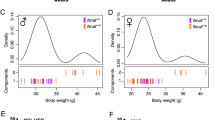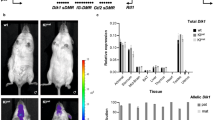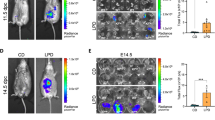Abstract
Genomic imprinting, by which maternal and paternal alleles of some genes have different levels of activity, has profound effects on growth and development of the mammalian fetus. The action of imprinted genes after birth, in particular while the infant is dependent on maternal provision of nutrients, is far less well understood. We disrupted a paternally expressed transcript at the Gnas locus, Gnasxl, which encodes the unusual Gsα isoform XLαs. Mice with mutations in Gnasxl have poor postnatal growth and survival and a spectrum of phenotypic effects that indicate that XLαs controls a number of key postnatal physiological adaptations, including suckling, blood glucose and energy homeostasis. Increased cAMP levels in brown adipose tissue of Gnasxl mutants and phenotypic comparison with Gnas mutants suggest that XLαs can antagonize Gsα-dependent signaling pathways. The opposing effects of maternally and paternally expressed products of the Gnas locus provide tangible molecular support for the parental-conflict hypothesis of imprinting.
This is a preview of subscription content, access via your institution
Access options
Subscribe to this journal
Receive 12 print issues and online access
$209.00 per year
only $17.42 per issue
Buy this article
- Purchase on Springer Link
- Instant access to full article PDF
Prices may be subject to local taxes which are calculated during checkout







Similar content being viewed by others
References
Cattanach, B.M. & Kirk, M. Differential activity of maternally and paternally derived chromosome regions in mice. Nature 315, 496–498 (1985).
Tycko, B. & Morison, I.M. Physiological functions of imprinted genes. J. Cell. Physiol. 192, 245–258 (2002).
Moore, T. & Haig, D. Genomic imprinting in mammalian development: a parental tug-of-war. Trends Genet. 7, 45–49 (1991).
Yu, S. et al. Variable and tissue-specific hormone resistance in heterotrimeric Gs protein alpha-subunit (Gsalpha) knockout mice is due to tissue-specific imprinting of the gsalpha gene. Proc. Natl. Acad. Sci. USA 95, 8715–8720 (1998).
Skinner, J.A., Cattanach, B.M. & Peters, J. The imprinted oedematous-small mutation on mouse chromosome 2 identifies new roles for Gnas and Gnasxl in development. Genomics 80, 373–375 (2002).
Cattanach, B.M., Peters, J., Ball, S. & Rasberry, C. Two imprinted gene mutations: three phenotypes. Hum. Mol. Genet. 9, 2263–2273 (2000).
Yu, S. et al. Paternal versus maternal transmission of a stimulatory G-protein alpha subunit knockout produces opposite effects on energy metabolism. J. Clin. Invest. 105, 615–623 (2000).
Davies, S.J. & Hughes, H.E. Imprinting in Albright's hereditary osteodystrophy. J. Med. Genet. 30, 101–103 (1993).
Weinstein, L.S., Yu, S., Warner, D.R. & Liu, J. Endocrine Manifestations of Stimulatory G Protein alpha-Subunit Mutations and the Role of Genomic Imprinting. Endocr. Rev. 22, 675–705 (2001).
Mantovani, G., Ballare, E., Giammona, E., Beck-Peccoz, P. & Spada, A. The gsalpha gene: predominant maternal origin of transcription in human thyroid gland and gonads. J. Clin. Endocrinol. Metab. 87, 4736–4740 (2002).
Germain-Lee, E.L. et al. Paternal imprinting of Galpha(s) in the human thyroid as the basis of TSH resistance in pseudohypoparathyroidism type 1a. Biochem. Biophys. Res. Commun. 296, 67–72 (2002).
Hayward, B.E. et al. Imprinting of the G(s)alpha gene GNAS1 in the pathogenesis of acromegaly. J. Clin. Invest. 107, R31–R36 (2001).
Kelsey, G. et al. Identification of imprinted loci by methylation-sensitive representational difference analysis: application to mouse distal chromosome 2. Genomics 62, 129–138 (1999).
Peters, J. et al. A cluster of oppositely imprinted transcripts at the Gnas locus in the distal imprinting region of mouse chromosome 2. Proc. Natl. Acad. Sci. USA 96, 3830–3835 (1999).
Hayward, B.E. et al. The human GNAS1 gene is imprinted and encodes distinct paternally and biallelically expressed G proteins. Proc. Natl. Acad. Sci. USA 95, 10038–10043 (1998).
Hayward, B.E., Moran, V., Strain, L. & Bonthron, D.T. Bidirectional imprinting of a single gene: GNAS1 encodes maternally, paternally, and biallelically derived proteins. Proc. Natl. Acad. Sci. USA 95, 15475–15480 (1998).
Ischia, R. et al. Molecular cloning and characterization of NESP55, a novel chromogranin- like precursor of a peptide with 5-HT1B receptor antagonist activity. J. Biol. Chem. 272, 11657–11662 (1997).
Kehlenbach, R.H., Matthey, J. & Huttner, W.B. XL alpha s is a new type of G protein. Nature 372, 804–809 (1994).
Klemke, M. et al. Characterization of the extra-large G protein alpha-subunit XLalphas. II. Signal transduction properties. J. Biol. Chem. 275, 33633–33640 (2000).
Bastepe, M. et al. Receptor-mediated adenylyl cyclase activation through XLalpha(s), the extra-large variant of the stimulatory G protein alpha-subunit. Mol. Endocrinol. 16, 1912–1919 (2002).
Coombes, C. et al. Epigenetic properties and identification of an imprint mark in the nesp-gnasxl domain of the mouse gnas imprinted locus. Mol. Cell. Biol. 23, 5475–5488 (2003).
Bunting, M., Bernstein, K.E., Greer, J.M., Capecchi, M.R. & Thomas, K.R. Targeting genes for self-excision in the germ line. Genes Dev. 13, 1524–1528 (1999).
Storck, T., Kruth, U., Kolhekar, R., Sprengel, R. & Seeburg, P.H. Rapid construction in yeast of complex targeting vectors for gene manipulation in the mouse. Nucleic Acids Res. 24, 4594–4596 (1996).
Voss, A.K., Thomas, T. & Gruss, P. Germ line chimeras from female ES cells. Exp. Cell Res. 230, 45–49 (1997).
Li, T. et al. Tissue-specific expression of antisense and sense transcripts at the imprinted Gnas locus. Genomics 69, 295–304 (2000).
Pasolli, H.A., Klemke, M., Kehlenbach, R.H., Wang, Y. & Huttner, W.B. Characterization of the extra-large G protein alpha-subunit XLalphas. I. Tissue distribution and subcellular localization. J. Biol. Chem. 275, 33622–33632 (2000).
Vollmer, R.R., Balcita, J.J., Sved, A.F. & Edwards, D.J. Adrenal epinephrine and norepinephrine release to hypoglycemia measured by microdialysis in conscious rats. Am. J. Physiol. 273, R1758–R1763 (1997).
Collins, S. & Surwit, R.S. The beta-adrenergic receptors and the control of adipose tissue metabolism and thermogenesis. Recent Prog. Horm. Res. 56, 309–328 (2001).
Bartness, T.J. & Bamshad, M. Innervation of mammalian white adipose tissue: implications for the regulation of total body fat. Am. J. Physiol. 275, R1399–R1411 (1998).
Zhou, Z. et al. Cidea-deficient mice have lean phenotype and are resistant to obesity. Nat. Genet. 35, 49–56 (2003).
Crawford, J.A. et al. Neural expression of a novel alternatively spliced and polyadenylated Gs alpha transcript. J. Biol. Chem. 268, 9879–9885 (1993).
Sutcliffe, J.G. & de Lecea, L. The hypocretins: setting the arousal threshold. Nat. Rev. Neurosci. 3, 339–349 (2002).
Berridge, C.W. & Waterhouse, B.D. The locus coeruleus-noradrenergic system: modulation of behavioral state and state-dependent cognitive processes. Brain Res. Brain Res. Rev. 42, 33–84 (2003).
Fay, R.A. & Norgren, R. Identification of rat brainstem multisynaptic connections to the oral motor nuclei in the rat using pseudorabies virus. II. Facial muscle motor systems. Brain Res. Brain Res. Rev. 25, 276–290 (1997).
Lund, J.P., Kolta, A., Westberg, K.G. & Scott, G. Brainstem mechanisms underlying feeding behaviors. Curr. Opin. Neurobiol. 8, 718–724 (1998).
Sawczuk, A. & Mosier, K.M. Neural control of tongue movement with respect to respiration and swallowing. Crit. Rev. Oral Biol. Med. 12, 18–37 (2001).
Wilkins, J.F. & Haig, D. What good is genomic imprinting: the function of parent-specific gene expression. Nat. Rev. Genet. 4, 359–368 (2003).
Hurst, L.D. Evolutionary theories of genomic imprinting. in Genomic Imprinting (eds. Reik, W. & Surani, A.) 211–237 (IRL, Oxford, 1997).
de la Casa-Esperon, E. & Sapienza, C. Natural selection and the evolution of genome imprinting. Annu. Rev. Genet. 37, 349–370 (2003).
Blass, E.M. & Teicher, M.H. Suckling. Science 210, 15–22 (1980).
Henning, S.J. Postnatal development: coordination of feeding, digestion, and metabolism. Am. J. Physiol. 241, G199–G214 (1981).
Yu, S. et al. Increased insulin sensitivity in Gsalpha knockout mice. J. Biol. Chem. 276, 19994–19998 (2001).
Ahren, B. Autonomic regulation of islet hormone secretion—implications for health and disease. Diabetologia 43, 393–410 (2000).
Young, J.B., Saville, E., Rothwell, N.J., Stock, M.J. & Landsberg, L. Effect of diet and cold exposure on norepinephrine turnover in brown adipose tissue of the rat. J. Clin. Invest. 69, 1061–1071 (1982).
Freson, K. et al. Functional polymorphisms in the paternally expressed XLalphas and its cofactor ALEX decrease their mutual interaction and enhance receptor-mediated cAMP formation. Hum. Mol. Genet. 12, 1121–1130 (2003).
Zheng, B. et al. RGS-PX1, a GAP for GalphaS and sorting nexin in vesicular trafficking. Science 294, 1939–1942 (2001).
Klemke, M., Kehlenbach, R.H. & Huttner, W.B. Two overlapping reading frames in a single exon encode interacting proteins—a novel way of gene usage. EMBO J. 20, 3849–3860 (2001).
Itier, J.M. et al. Imprinted gene in postnatal growth role. Nature 393, 125–126 (1998).
Yang, T. et al. A mouse model for Prader-Willi syndrome imprinting-centre mutations. Nat. Genet. 19, 25–31 (1998).
Williamson, C.M. et al. Imprinting of distal mouse chromosome 2 is associated with phenotypic anomalies in utero. Genet. Res. 72, 255–265 (1998).
Acknowledgements
We thank W. Reik, P. Hawkins and A. Vidal-Puig for their support and comments on the manuscript; E. Walters for statistical analysis of the data; T. Storck and K. Thomas for providing precursor plasmids for pRAY-Cre; A. Voss for the ES cell line MPI-VI; and the staff at Babraham animal facilities for dedicated husbandry. This work was supported by an Medical Research Council senior fellowship to G.K. and by the Biotechnology and Biological Sciences Research Council.
Author information
Authors and Affiliations
Corresponding author
Ethics declarations
Competing interests
The authors declare no competing financial interests.
Supplementary information
Supplementary Fig. 1
The Gnasxl mutation does not alter the methylation state of the Gnasxl and Nesp DMRs in cis. (PDF 110 kb)
Rights and permissions
About this article
Cite this article
Plagge, A., Gordon, E., Dean, W. et al. The imprinted signaling protein XLαs is required for postnatal adaptation to feeding. Nat Genet 36, 818–826 (2004). https://doi.org/10.1038/ng1397
Received:
Accepted:
Published:
Issue Date:
DOI: https://doi.org/10.1038/ng1397
This article is cited by
-
Imprinted genes and the manipulation of parenting in mammals
Nature Reviews Genetics (2023)
-
Placental imprinting of SLC22A3 in the IGF2R imprinted domain is conserved in therian mammals
Epigenetics & Chromatin (2022)
-
Patients with PWS and related syndromes display differentially methylated regions involved in neurodevelopmental and nutritional trajectory
Clinical Epigenetics (2021)
-
Pseudohypoparathyroidism, acrodysostosis, progressive osseous heteroplasia: different names for the same spectrum of diseases?
Endocrine (2021)
-
The Distinct Role of the Extra-Large G Protein ɑ-Subunit XLɑs
Calcified Tissue International (2020)



